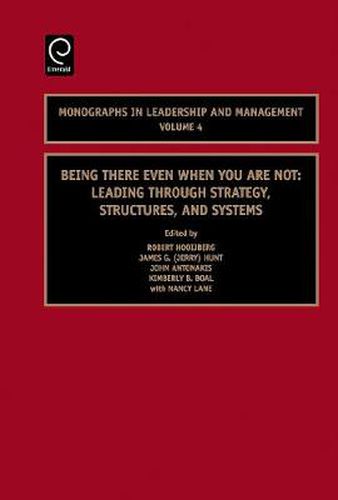Readings Newsletter
Become a Readings Member to make your shopping experience even easier.
Sign in or sign up for free!
You’re not far away from qualifying for FREE standard shipping within Australia
You’ve qualified for FREE standard shipping within Australia
The cart is loading…






Whereas most of the leadership literature has focused on direct, interpersonal leadership, few researchers have examined indirect leadership or the leadership of organizations. Of course, direct, personal leadership plays an important role at all levels of the organization. However, we focus here on how leaders use strategy, structures, and systems to create the conditions that stimulate others to meaningfully contribute to the overarching goals of the organization. We therefore explore the role of the strategic leader as an architect.In this role as strategic architect, we examine how top-level leaders create organizations wherein leadership is developed, knowledge is created and disseminated, meaning is shaped and shared, and where the vision cascades to all corners of the organization. We also explore the darker side of leader discretion to show the deleterious consequences of leader power. Finally, we examine the complex nature of organizations and the roles of leaders in adapting the organization to the environment in which it operates. The six major sections in this book coincide with these aspects of the leaders architectural focus. The first chapter in each section provides a short theoretical introduction. Following the theory chapters are application chapters, highlighting the practical implications of the theory with real-life examples.The sixth section explores the relationship between complexity theory and strategic leadership. It examines indirect leadership - the leadership OF organizations. It explores how leaders exercise leadership indirectly through structures, processes and systems that stimulate others to contribute to organizational goals. It contains six major sections: leadership development, knowledge management, influencing and shaping meaning, leader discretion, vision cascading, and complexity theory and the networked organization.
$9.00 standard shipping within Australia
FREE standard shipping within Australia for orders over $100.00
Express & International shipping calculated at checkout
Stock availability can be subject to change without notice. We recommend calling the shop or contacting our online team to check availability of low stock items. Please see our Shopping Online page for more details.
Whereas most of the leadership literature has focused on direct, interpersonal leadership, few researchers have examined indirect leadership or the leadership of organizations. Of course, direct, personal leadership plays an important role at all levels of the organization. However, we focus here on how leaders use strategy, structures, and systems to create the conditions that stimulate others to meaningfully contribute to the overarching goals of the organization. We therefore explore the role of the strategic leader as an architect.In this role as strategic architect, we examine how top-level leaders create organizations wherein leadership is developed, knowledge is created and disseminated, meaning is shaped and shared, and where the vision cascades to all corners of the organization. We also explore the darker side of leader discretion to show the deleterious consequences of leader power. Finally, we examine the complex nature of organizations and the roles of leaders in adapting the organization to the environment in which it operates. The six major sections in this book coincide with these aspects of the leaders architectural focus. The first chapter in each section provides a short theoretical introduction. Following the theory chapters are application chapters, highlighting the practical implications of the theory with real-life examples.The sixth section explores the relationship between complexity theory and strategic leadership. It examines indirect leadership - the leadership OF organizations. It explores how leaders exercise leadership indirectly through structures, processes and systems that stimulate others to contribute to organizational goals. It contains six major sections: leadership development, knowledge management, influencing and shaping meaning, leader discretion, vision cascading, and complexity theory and the networked organization.